Gardens of Florence

In fifteenth-century Florence, gardens became veritable places of the spirit, areas dedicated to meditation and philosophical speculation. Born as the ideal settings for the meetings for the neo-Platonic school of Marsilius Ficinus, gardens increasingly more acquired the features of a place of leisure and celebration of grand-ducal power as of the XVI century. These complex set designs of greenery and water were the fruit of a refined knowledge of architecture and hydraulics.
Gardens and Humanism
The theoretical foundations of the garden art were defined with the rediscovery of the classical world during the Age of Humanism. In the treatise De Re Aedificatoria, Leon Battista Alberti theorised the ideal of villa and garden: both had to translate the classical concept of otium, quiet life, a concept closely tied to the civil and cultural demands of the new merchant bourgeoisie. The garden was thus acknowledged a social purpose.
Architecture and Gardens
The attention of the major early-Renaissance writers of treatises fully introduced the garden art into the area of architecture. The garden was no longer the medieval hortus conclusus – an intimate area with geometric beds surrounded by walls, and in keeping with precise religious values. Thanks to a privileged relationship with the landscape, it acquired new and more modern possibilities for formal development
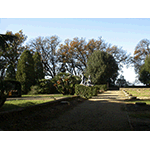
The Early Medici Villas
The new sensitivity around garden design was immediately reflected in the villas that the Medici built or purchased in the vicinity of Florence. The Villa of Cafaggiolo was renovated by Michelozzo in 1451 on behalf of Cosimo the Elder. At the Villa of Careggi, also by Michelozzo, Lorenzo the Magnificent founded the Platonic Academy: it was in this villa’s garden that Marsilius Ficinus studied the therapeutic virtues of plants. The villa at Poggio a Caiano that Lorenzo the Magnificent purchased in 1479, was enlarged and renovated by Giuliano da Sangallo. Finally, at the villa of Fiesole, the Magnificent loved to immerge himself in poetic contemplation in the company of his guests.
|
"Cerchi chi vuol le pompe, e gli altri onori Le piazza, e i templi; e gl’edifici magni, Le delizie, il tesor, quale accompagni Mille duri pensier, mille dolori Un verde praticel pien di bei fiori, Un rivolo che l’erba intorno bagni Un augelletto, che d’amor si lagni, Acqueta molto meglio i nostri ardori" |
"Let he who will, seek pomp and honours, fame, temples, and great buildings, Delights, and treasure as companion to A thousand harsh thoughts, a thousand pains. A green meadow in full flower, A brook grazing grassy banks, A bird that cries for love Are much more soothing of passions" |
(Lorenzo the Magnificent, sonnet XXX of the Commentary)
City Gardens
The "villa garden" therefore translated an ideal of nature proper to Florentine Neo-Platonic culture, on one hand, and to the courtly patronage that found its highest expression in Lorenzo the Magnificent, on the other hand. A garden was also planted in the city, in the palazzo on the via Larga, built by Michelozzo by order of Cosimo the Elder de’ Medici, where the hedges were modelled into animal shapes; ancient sculptures and bas reliefs were instead assembled in a second courtyard. As Giorgio Vasari narrates, Lorenzo also wanted the garden of San Marco to be a museum of antiquities where artists could practise. The garden indeed hosted the greatest artists of the time: Sandro Botticelli, Filippino Lippi, Domenico Ghirlandaio, Leonardo, and Michelangelo who amazed the prince by sculpting a legendary faun’s head. In this refined cultural setting, dominated by the Neo-Platonic ideals, the garden was extolled by poets and painted by painters. In the late 15th century, all of Florence was a garden. Chroniclers reported many: in his Cronica Fiorentina, Benedetto Dei reports some 138 gardens.
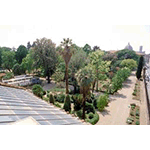
The Age of Cosimo I
The duchy of Cosimo I dei Medici was a period of extraordinary vitality in every area of culture. Medici interest in the sciences was decisive for the development of the garden art. The impetus given to botanical studies by Cosimo I, responsible for instituting the Medicinal Herb Garden in 1545, was directly connected to the birth of the gardens of Florentine noblemen. Halfway through the century, the Serristori, Pandolfini and many other gardens were renowned for beauty and splendour.
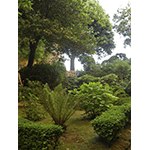
Hanging Gardens
The preferred typology of suburban garden was the hanging garden, that is to say, a garden in complete symbiosis with a building. Among the first and most spectacular hanging gardens was the one built by Francesco I on the Loggia dei Lanzi, installed between 1583 and 1585, while Dominican friar Agostino Del Riccio also recalled the Acciaiuoli Garden: «Alessandro Acciaiuoli has begun to show how fine hanging gardens should be made, one on top of another, and so on to the top of the roof and all with good air, beds, fountains, espaliers and vases; and so these hanging gardens can be entered from several rooms of the house, offering great comfort to they who inhabit these houses and can go directly from the house into the garden».
Tribolo
One of the protagonists of the garden art in sixteenth-century Florence was Niccoḷ di Raffaello, known as Tribolo. His projects included the garden of the Villa at Castello, created around 1540 under commission to Cosimo I, so abundant in allegorical and symbolic references as to prove among the most significant examples of Renaissance gardens. Around the middle of the century, he also designed the Boboli Garden behind the palace of Luca Pitti, which Cosimo purchased as his new city residence and where, at his death, Tribolo was succeeded first by Luca Ammannati and then by Bernardo Buontalenti.
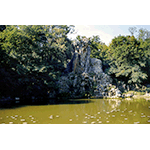
Buontalenti
One of the most extraordinary architectural feats was the arrangement of the large park of the Villa at Pratolino, entrusted to Buontalenti by Francesco I. The ingenious architect organised the park with such a wealth of themes and suggestions as to become a model reflection of Florentine Mannerist culture during the duchy of the "Prince of the Studiolo". Buontalenti also authored more or less elaborate operations at the other Medici villas: Petraia, Marignolle, Màgia, Cerreto Guidi, Artimino and Ambrogiana.
-
 Medici Villa 'La Ferdinanda'
Medici Villa 'La Ferdinanda' -
 Medici Villa 'La Màgia'
Medici Villa 'La Màgia' -
 Medici Villa L'Ambrogiana
Medici Villa L'Ambrogiana -
 Medici Villa of Marignolle
Medici Villa of Marignolle -
 Parco Mediceo di Pratolino - Villa Demidoff [Medici Park at Pratolino - Villa Demidoff]
Parco Mediceo di Pratolino - Villa Demidoff [Medici Park at Pratolino - Villa Demidoff] -
 Villa Medicea di Cerreto Guidi - Museo Storico della Caccia e del Territorio [Medici Villa at Cerreto Guidi - Historical Museum of Hunting and the Territory]
Villa Medicea di Cerreto Guidi - Museo Storico della Caccia e del Territorio [Medici Villa at Cerreto Guidi - Historical Museum of Hunting and the Territory]
The Baroque Garden
In the course of the 17th century, the interest for the art of gardens was witnessed by the intense activity of architects Giulio and Alfonso Parigi at Poggio Imperiale and Boboli, where they interpreted a refined culture capable of combining figurative and literary meditations with strong theatrical suggestions. Also noteworthy are the projects by Antonio Novelli in the "Oricellari" Gardens and by Gherardo Silvani at the Villa Corsi in Sesto.
The Garden in the 18th Century
In the course of the 18th century, the thrust of Lorraine reformism profoundly influenced the city’s appearance. In 1775, the "public" Museum of Natural History was instituted, adjoined by a garden, while ten years later, Giuseppe Manetti began works aimed at rearranging the Parco delle Cascine.
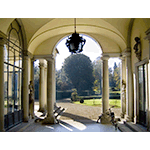
The English Garden
The fashion of the landscape garden spread in the early 19th century. Marquis Tommaso Corsi built the first "English" garden in Florence, entrusting the project to Giuseppe Manetti. The Serristori, Corsini, Guicciardini and Gherardesca gardens were also adapted to the English style. The garden of marquis Pietro Torrigiani and the Horti Oricellari of Giuseppe Stiozzi Ridolfi were modified by Luigi de Cambray Digny; the garden of Villa Corsi in Sesto was transformed to the "English style" in 1815, on the advice and project of scholar Francesco Inghirami. In the first two decades of the century, the grand-ducal gardens of Poggio a Caiano, Poggio Imperiale, Petraia, Castello, Pratolino and Boboli were subjected to radical renovation, despite criticism from the strenuous defenders of the old charm of the Italian garden, and involved capable architect-gardeners such as Manetti, Cambray Digny, Joseph Frietsch, Giuseppe Cacialli, and Giuseppe Del Rosso.
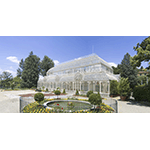
Gardens in the 19th Century
The passion for gardens was an important aspect of neoclassical and romantic culture. The young Antonio Piccioli realised delicate watercolours depicting the most beautiful specimens cultivated in the garden of the Museo di Fisica e Storia Naturale. In 1825, Antonio Targioni Tozzetti published in Florence his Raccolta di fiori, frutti ed agrumi più ricercati per l'adornamento dei giardini disegnati al naturale da vari artisti [Collection of the most sought-after flowers, fruit and citrus trees for the adornment of gardens designed in the natural style by various artists]. In 1854, the Tuscan Horticultural Society, which organised annual shows of plants and flowers in the most famous Florentine gardens, was founded. Later, the brilliant activity of architect Giuseppe Poggi was to characterise the gardens of Florence as capital of Italy.
****************************
Texts by Alessandro Tosi
English translation by Victor Beard
Last update 30/gen/2008


